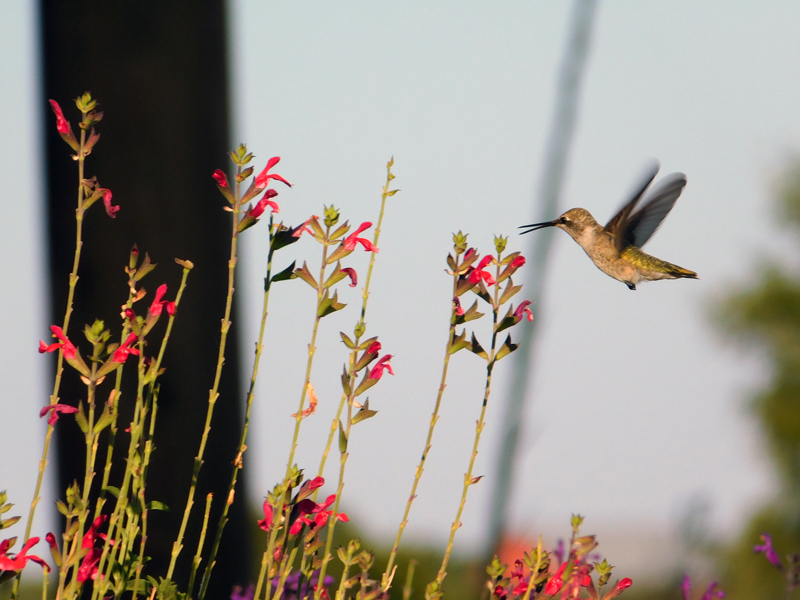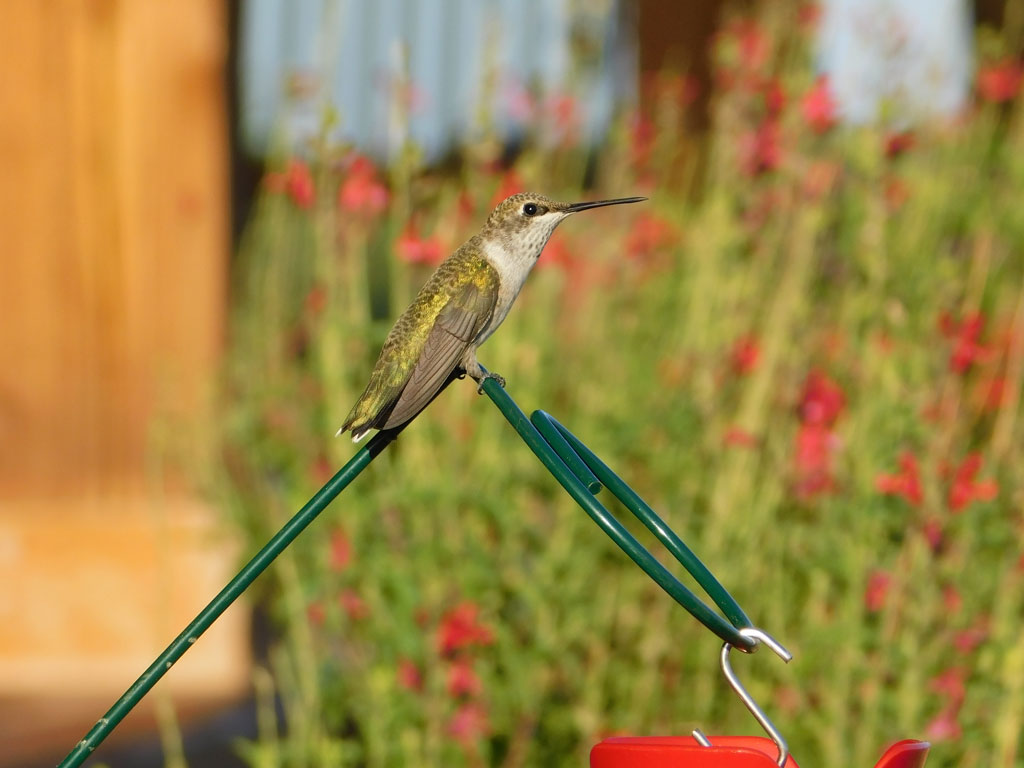
A hummingbird feeds on the nectar of red sage. Staff photo by Jennifer Greenwell
If you feed them, they will come.
Hummingbirds. These tiny, spectacular creatures return each year to the Highland Lakes and much of Texas, and if you are lucky, you are in for a show. The southern migration of ruby-throated and black-chinned hummingbirds, the varieties largely seen in the Highland Lakes, should peak August through September.
There are more 330 species of hummingbirds found only in the Western Hemisphere. Of the fewer than two dozen species in North America, Texas hosts as many as 18 species. According to the Texas Hummingbird Roundup Final Report, it is not unusual for the Highland Lakes to have visitors from these eight species: Allen’s, Anna’s, black-chinned, broad-tailed, calliope, green violet-ear, ruby-throated, and Rufous.
Hummingbirds are as amazing as they are delightful. Here are some very cool and interesting hummingbird facts you might find simply incredible:
- Their wings beat up to 55 times per second.
- They are the only bird species that can hover and fly backward or upside down.
- Hummingbirds cannot walk or hop but shuffle — their legs are not very strong.
- They have no sense of smell but very sharp eyesight.
- When hovering, their energy output is 10 times that of a man running 9 mph.
- They have the highest energy output per unit of body weight of any animal in the world.
- They go into a deep rest period at night called “torpor” during which the heart rate slows.
- They have a variety of calls, chips, chatters, and squeals to communicate with each other.
- Different species have their own “language.”
- The average life span of the ruby-throated hummingbird is estimated to be 3-5 years.
- An average ruby-throated hummingbird weighs 3 grams. (For comparison, a nickel weighs 4.5 grams.)
- Their maximum forward flight speed is about 30 mph, but they can reach up to 60 mph in a dive.
- A hummingbird egg is smaller than a jelly bean at less than one-half inch long.
- Hummingbirds do not suck nectar, they lick it with fringed or forked tongues.
- The hummingbird is one of most aggressive bird species and will attack jays, crows, and hawks that invade their territory.

A hummingbird at rest. Fun fact: The bird can beat its wings up to 55 times per second. Staff photo by Jennifer Greenwell
The Texas Hill Country and Highland Lakes typically see the ruby-throated and the black-chinned varieties of hummingbirds each year. Some remain year-round, but most are seen during migration periods.
The spring migration may start as early as January and run through mid-May. The birds migrate north to their breeding grounds. The fall migration south often runs from July through into September.
Black-chinned hummingbirds are usually the only species that breeds in Texas.
Male hummingbirds are the first to migrate, followed by females and juveniles. The birds gather in Texas, Louisiana, and Florida in preparation for the final push south over the Gulf of Mexico — some do migrate over land.
Hummingbirds will frequent feeders during these times.
Do not buy into the myth that leaving feeders up in the fall will prevent hummingbirds from migrating. This is not true. Leaving the feeders up can help the birds re-fuel during their migration. In Texas, it is possible to have year-round residents. They welcome the food supply from feeders when flowers are no longer blooming.
If you would like to attract some of these entertaining passersby during their migration periods, or keeping the locals happy, follow these guidelines:
- Use the right recipe. Too weak or too strong nectar is not appealing. Use plain sugar.
- Clean the feeder regularly. Never use bleach.
- It is not necessary, and may be harmful, to use red dye. Hummingbirds will be attracted to the red feeder itself.
- Change the nectar before it grows cloudy. Sugar water quickly ferments in hot weather, producing toxic alcohol.
- Hang the feeder where it will be noticeable.
- Make sure it is in a convenient spot for monitoring and maintenance.
- Place the feeder in a safe location so predators cannot get the feeding birds.
- Make sure the feeder is easily accessible for the bird to fly in and near trees and brush for shelter.
- Be mindful of windows when placing feeders to avoid a collision with the glass.
- Provide water in the area such as a bird bath or shallow fountain.
- Plant hummingbird-attracting plants nearby.
EASY NECTAR RECIPE
1:4 mixture — one part white granulated sugar to four parts tapwater.Stir until sugar is completely dissolved. Do not add food coloring.
Feeders should be a supplementary food source in addition to natural food sources. Some of the native flowers that hummingbirds go wild for include: firecracker plant, hummingbird bush, Texas lantana, purple sage, Texas plume, coral honeysuckle, purple horsemint, Hill Country beardtongue, phlox, and red sage.
jgreenwell@thepicayune.com











